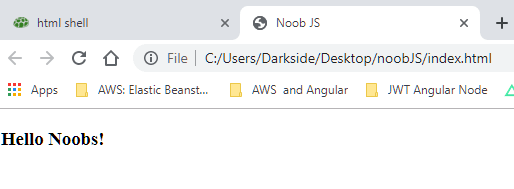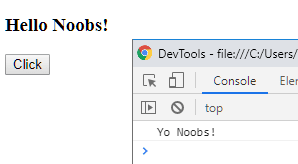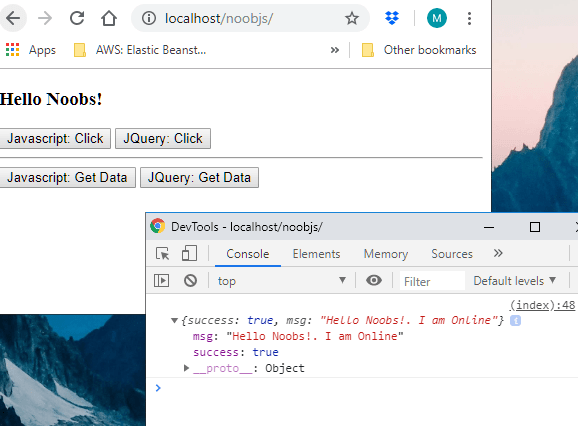I have been haunted and daunted by Javascript for almost a decade i.e. 10+ Years. These years do make a history for me in programming. Today while teaching one of my newly made friends on a quick course to programming, I stumbled upon some things that I should share and that is Javascript. Let us try to understand it with some examples.
Introduction and History
The web has been inclined towards Javascript which made its cover in 1996. A company by the name of Netscape which was famous for its speedy browsers in the mid 90s submmited it to the ECMA International to produce a standardized language which other browsers could implement. I still remember the awe at Netscape Navigator in the 90s. Today we know an entity by the name of Mozilla, a portmanteau of Mosaic and Godzilla. The first version was Mosiac Netscape 0.9, released in 1994.
Implementation of Javascript in Browser Code
Lets create a folder on your desktop by the name of noobJS and make an index.html file in it. For HTML boilerplate code, I will be using http://htmlshell.com/
<!DOCTYPE html>
<html>
<head>
<meta charset="UTF-8">
<meta http-equiv="X-UA-Compatible" content="IE=edge,chrome=1">
<meta name="viewport" content="width=device-width,initial-scale=1">
<title>Noob JS</title>
</head>
<body>
<h3>Hello Noobs!</h3>
</body>
</html>
Now if you double click the file, it will run in the browser.
Button Click Through Vanila JS
<body>
<h3>Hello Noobs!</h3>
<button id="myFirstButton">Click</button>
<script>
document.getElementById('myFirstButton').onclick = function(e) {
console.log("Yo Noobs!");
}
</script>
</body>
To start Javascript, we open a "script" tag and then close it with the same tag name. Everything in between is Javascript.
"document " is a reference to the current screen which is in view. Now using the getElementById function for document means that Javascript is going to search all elements that have an ID of myFirstButton. An element can be anything from a button or a H3 or any HTML Tag which can be given an ID just by specifying id in it.
Now if you right click the browser and click inspect, we will have a console where we can print information using the console.log() function.
Now refresh on the browser and click the button.
What is JQuery?
JQuery is javascript just making it easier to write and more easier to use. It is like re-arranging the same language so that I can make it shorter, more abbreviated hence faster to implement. I would like to metaphorize it as typing Laugh Out Loud again and again but I would prefer using Lol and expect the reader to understand it.
Lets write the same click function in JQuery. We will first import JQuery using a CDN (Content Delivery Network). Head over to https://code.jquery.com/ and click on minified jQuery Core 3.4.1
<head>
<meta charset="UTF-8">
<meta http-equiv="X-UA-Compatible" content="IE=edge,chrome=1">
<meta name="viewport" content="width=device-width,initial-scale=1">
<title>Noob JS</title>
<script src="https://code.jquery.com/jquery-3.4.1.min.js"
integrity="sha256-CSXorXvZcTkaix6Yvo6HppcZGetbYMGWSFlBw8HfCJo=" crossorigin="anonymous"></script>
</head>
Add it to the Head of the index.html file
<body>
...
<button id="mySecondBUtton">JQuery: Click</button>
...
</body>
<script>
document.getElementById('myFirstButton').onclick = function(e) {
console.log("Yo Noobs!");
}
$('#mySecondBUtton').click((e) => {
console.log("Not a Noob Anymore!! Heh!!");
});
</script>
Now JQuery once imported initializes with the tag of "$" and then comes the brackets which in quotes becomes a selector from the document. If with context to javascript this is getElementBy, it can either be a class with a dot or a id with a Hash. Therefore, if you compare it is way shorted just like LOLs.
Making a GET Call using Vanila JS
Lets try to fetch some data through a Get Call, so that we are now communicating in the Javascript. First we need some Mock API and we have a tool for it. Head over to https://www.mocky.io/ and scroll down to the body. We will write a simple response in JSON (Javascript Object Notation).
Now click on Generate and it will give you an endpoint for the Get Call.
Next create a new button and call it in the script tab
<body>
...
<button id="myFirstCall">Javascript: Get Data</button>
...
</body>
<script>
...
document.getElementById('myFirstCall').onclick = function(e) {
var xhttp = new XMLHttpRequest();
xhttp.onreadystatechange = function() {
if (this.readyState == 4 && this.status == 200) {
console.log(this.responseText);
}
};
xhttp.open("GET", "http://www.mocky.io/v2/5da666b83400001528633045", true);
xhttp.send();
}
...
</script>
Javascript has an class that handles all the API in the form of an object. This object allows transfer of data between a web browser and a web sever. We have created an object as var xhttp. Next we are listening if there is a change of state which detects whether the call has been run or not. this.readyState is 4 when everything is OK, which puts in a nice check so that during the call we dont break the code and response of 200 means all is good that the webserver responded successfully with some data. this.responseText contains the required data that we want to attain.
Next we open the connection and then we send the request. Lets refresh the page and click the button.
As you can see we now have the response with all the wiggly brackets. Let convert the response into an object by parsing the JSON.
if (this.readyState == 4 && this.status == 200) {
console.log(JSON.parse(this.responseText));
}
As you can see by just using JSON.parse() we are able to convert the response from wiggly to usable object. To get the message you can use the following code now;
JSON.parse(this.responseText).msg
Making a Get Call using JQuery
Lets do the same thing with JQuery
<body>
...
<button id="mySecondCall">JQuery: Get Data</button>
...
</body>
<script>
...
$('#mySecondCall').click((e) => {
$.ajax({
type: 'GET',
dateType: 'JSON',
url: 'http://www.mocky.io/v2/5da66a18340000a99963304c',
success: function (data) {
console.log(data);
},
error: function (error) {
console.log(data);
}
});
});
...
</script>
Jquery has a ajax function for making communication with a web server. Ajax stands for Advanced Java and XML. You provide it with the type of call, type of response and the url and it handles the states in simple readable language.
As you can see the same code has been made minimal with the same type of response.
Conclusion
Going through Vanilla JS really makes up concept to the what is happening first hand. I do recommend everyone to attleast go through it so that a better level of understanding can be made but do acknowledge on the other hand the importance of saving time and hassle. Re-inventing the wheel does not bring much change and innovation but in todays time utilizing libraries to speed up work and save time is what one should prefer.
Complete Code ~ index.html
<!DOCTYPE html>
<html>
<head>
<meta charset="UTF-8">
<meta http-equiv="X-UA-Compatible" content="IE=edge,chrome=1">
<meta name="viewport" content="width=device-width,initial-scale=1">
<title>Noob JS</title>
<script src="https://code.jquery.com/jquery-3.4.1.min.js"
integrity="sha256-CSXorXvZcTkaix6Yvo6HppcZGetbYMGWSFlBw8HfCJo=" crossorigin="anonymous"></script>
</head>
<body>
<h3>Hello Noobs!</h3>
<button id="myFirstButton">Javascript: Click</button>
<button id="mySecondBUtton">JQuery: Click</button>
<hr>
<button id="myFirstCall">Javascript: Get Data</button>
<button id="mySecondCall">JQuery: Get Data</button>
<script>
document.getElementById('myFirstCall').onclick = function(e) {
var xhttp = new XMLHttpRequest();
xhttp.onreadystatechange = function() {
if (this.readyState == 4 && this.status == 200) {
console.log(JSON.parse(this.responseText));
}
};
xhttp.open("GET", "http://www.mocky.io/v2/5da66a18340000a99963304c", true);
xhttp.send();
}
document.getElementById('myFirstButton').onclick = function(e) {
console.log("Yo Noobs!");
}
$('#mySecondBUtton').click((e) => {
console.log("Not a Noob Anymore!! Heh!!");
});
$('#mySecondCall').click((e) => {
$.ajax({
type: 'GET',
dateType: 'JSON',
url: 'http://www.mocky.io/v2/5da66a18340000a99963304c',
success: function (data) {
console.log(data);
},
error: function (error) {
console.log(data);
}
});
});
</script>
</body>
</html>
 th3n00bc0d3r
/
vanilajsvsjquery
th3n00bc0d3r
/
vanilajsvsjquery
A comparison of Vanilla JS to Jquery to develop and understanding
Vanila JS to Jquery: The Noobs Guide
I have been haunted and daunted by Javascript for almost a decade i.e. 10+ Years. These years do make a history for me in programming. Today while teaching one of my newly made friends on a quick course to programming, I stumbled upon some things that I should share and that is Javascript. Let us try to understand it with some examples.
Introduction and History
The web has been inclined towards Javascript which made its cover in 1996. A company by the name of Netscape which was famous for its speedy browsers in the mid 90s summited it to the ECMA International to produce a standardized language which other browsers could implement. I still remember the awe at Netscape Navigator in the 90s. Today we know an entity by the name of Mozilla, a portmanteau of Mosaic and Godzilla. The first version was…
References
https://en.wikipedia.org/wiki/JavaScript
https://www.webdesignmuseum.org/web-design-history/mosaic-netscape-0-9-1994
















Top comments (5)
The web is a crazy place and has a lot of old tutorials out there. All of this will work (because of backwards compatibility), BUT there is a better way (that a developer just learning JavaScript might never know how to find, because there are a TON of jQuery examples that use the old
XMLHttpRequestAJAX calls.)If you look towards the bottom of the Wikipedia link in your story, you'll see a header for the "Fetch Alternative". For practical daily programming, it's the "Fetch Replacement" as it's been implemented in every modern browser.
If you have to support IE (Please don't... supporting IE has gotten to the point that it is literally unethical to write code for it. You can tell companies this until you're blue in the face, but some just refuse to stop installing a virus onto their machines hahaha), there is a polyfill.
Fetch API Docs
Fetch Polyfill
So that would change your vanilla JS implementation to:
OR, if you love the .then syntax from promises:
fetch just lends itself to a slightly more condensed, but MUCH more readable code, that improves on the
XMLhttpRequestsyntax, and is both thenable, so it can use the Promise API that followed XMLHttpRequest, or the newer async/await format.It also removes ANY external dependency (which is the real benefit... no need to include jQuery)
Both of those examples were tested in a bare HTML file from my desktop with no
other code in the file. Copy and paste them exactly into an HTML file on your desktop and (except for the mock implementation) they should "just work™"
Great Response .. Cheers Up... would you like to co-author a book I am compiling. Its just wonderful to find helping hands over here. Your context could be used to further make a stronger concept of how things work on a basic level, so that a strong grip on higher level code is achievable.
I miss JQuery 😎
.click(func) event shorthand is deprecated in JQuery 3.
Instead you should use .on('click', func)
Thanks Buddy, its just a very basic intro.